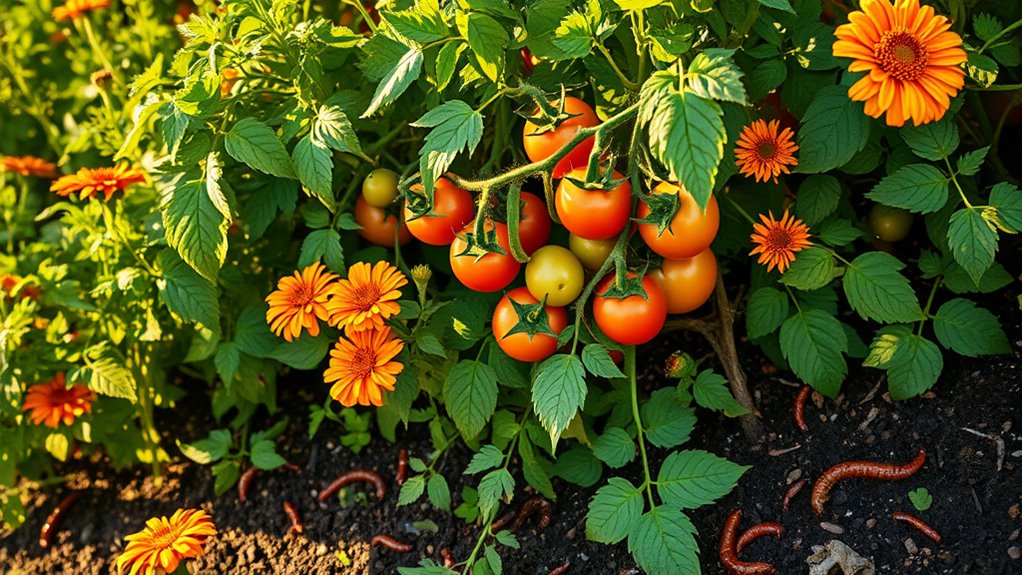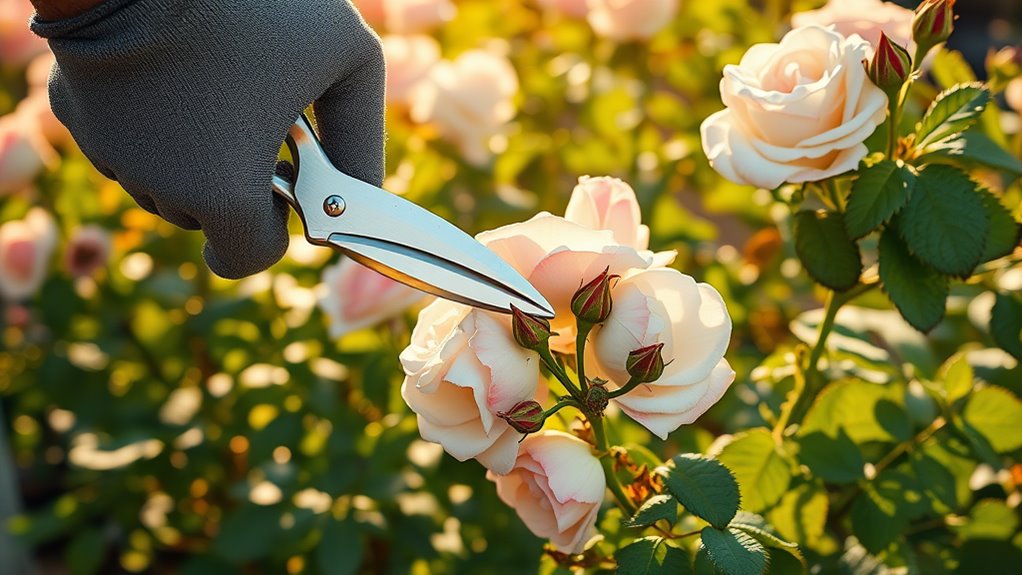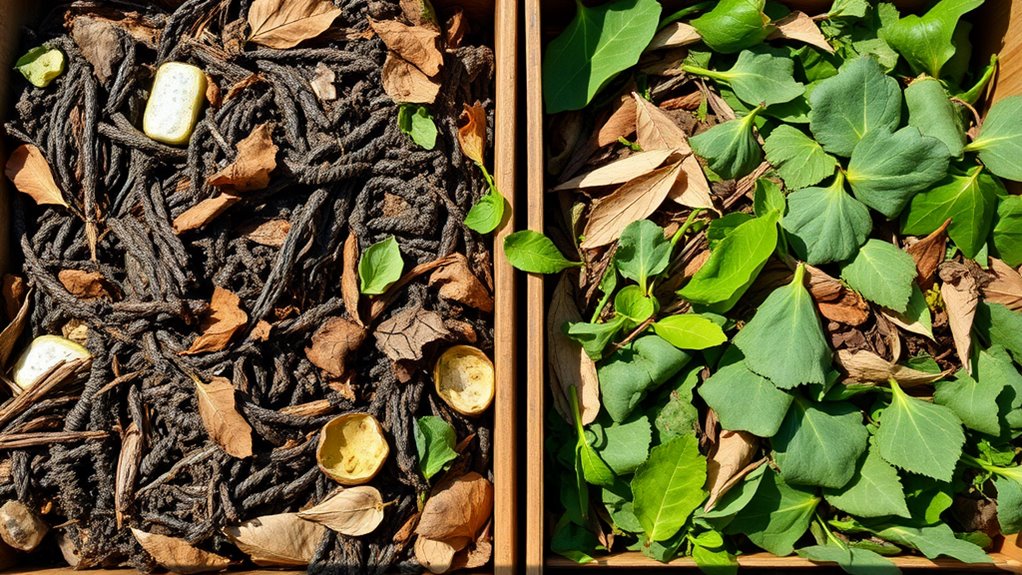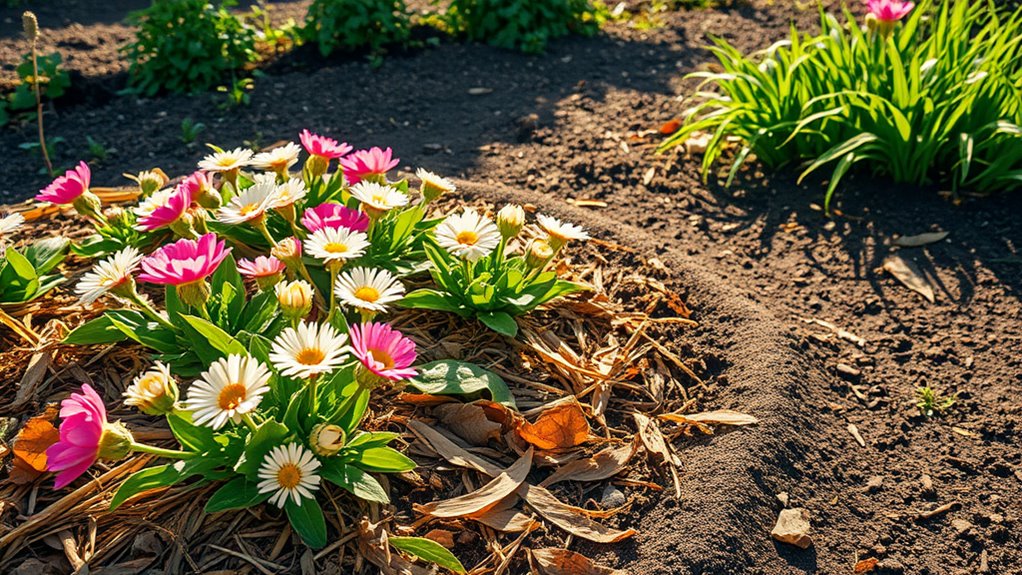Why My Garden Is Thriving Without Store-Bought Fertilizer
You’re making your garden thrive without store-bought fertilizers by harnessing natural methods like composting kitchen scraps, which enrich your soil with essential nutrients for healthier plants. Mulching retains moisture and suppresses weeds, while companion planting boosts growth and pest resistance through strategic pairings. Harnessing rainwater and worm farming further enhance your ecosystem’s balance. These simple techniques create a vibrant garden; stick around for more tips to elevate your green space even more.
Key Takeaways
- Composting kitchen scraps enriches soil with natural nutrients, boosting plant growth and microbial activity.
- DIY organic fertilizers from items like banana peels provide essential potassium, supporting fruiting plants without synthetic alternatives.
- Mulching with organic materials retains moisture and suppresses weeds, enhancing soil health and plant resilience.
- Companion planting pairs like basil with tomatoes naturally repel pests and improve growth through synergistic effects.
- Rainwater harvesting and worm farming supply water and nutrients, maintaining a balanced ecosystem for thriving gardens.
The Benefits of Composting at Home
If you’re looking to boost your garden’s health without relying on store-bought fertilizers, composting at home offers a straightforward solution that enriches your soil naturally.
As a proven natural fertilizing method, it transforms kitchen scraps and yard waste into nutrient-packed humus, enhancing soil structure and water retention for robust plant growth.
You’ll reduce household waste, foster beneficial microbes, and save money while promoting eco-friendly practices. Additionally, by utilizing everyday compost ingredients from your kitchen, you can transform your trash into nutrient-rich soil to support healthier plants and a more sustainable garden.
By following organic composting tips, you can effectively recycle specific kitchen scraps and garden waste to further enhance soil health and sustainable practices.
DIY Organic Fertilizer Recipes
While you’ve harnessed composting to enrich your soil, you can easily craft your own DIY organic fertilizer recipes using common household items.
Start with banana peels: chop them finely, soak in water for a week, then strain and apply the liquid to fruiting plants for a potassium boost.
For calcium, rinse and crush eggshells, sprinkling them around seedlings to strengthen roots.
Brew a nitrogen-rich tea by steeping coffee grounds in water for a few days, dilute it, and water leafy greens.
Mix Epsom salt with water for a magnesium solution, spraying it on plants for better growth.
Test each recipe on a small area first.
Incorporating banana peels as described can further promote healthier growth in your garden, enhancing overall plant vitality.
By implementing these recipes, you can boost your garden using easily accessible ingredients to achieve bigger, stronger plants.
Improving Soil Health Naturally
You can boost your garden’s soil health naturally by adding compost, which enriches it with essential nutrients from kitchen scraps and yard waste.
Start by mixing a layer of homemade compost into your soil to enhance its structure and microbial activity.
Then, apply mulch like leaves or straw around plants to retain moisture and suppress weeds effectively.
To maintain an effective composting process, be sure to address common composting issues that could affect soil quality.
This approach utilizes natural soil preparation techniques to significantly enhance your harvest without the need for fertilizers.
Compost Addition
Compost addition revitalizes soil health by introducing a rich mix of organic matter that enhances nutrient availability and structure.
You’ll transform your garden by adding this natural booster, fostering a thriving ecosystem without chemicals.
To maximize benefits, follow these steps:
-
Source your compost: Gather kitchen scraps, leaves, and yard waste; let it decompose for weeks to create nutrient-dense material.
-
Test soil first: Check pH and nutrients to determine how much compost you need—aim for 2-4 inches layered on beds.
-
Incorporate evenly: Use a garden fork to mix it into the top 6-8 inches of soil, ensuring even distribution for better root access.
-
Water and wait: Lightly water after application and monitor; you’ll see improved moisture retention and microbial activity within weeks.
Mulch Application
Mulching boosts soil health naturally by shielding it from erosion and retaining moisture. You select organic materials like straw, bark, or leaves, then spread a 2-4 inch layer evenly around your plants, keeping it away from stems to prevent rot.
This suppresses weeds, regulates soil temperature, and enriches the soil as mulch decomposes, releasing nutrients slowly. Apply it in early spring or after rains for best results; you’ll minimize water loss and pest issues.
Refresh annually to sustain benefits—it’s practical, cost-effective, and turns your garden into a thriving, chemical-free haven.
Using Kitchen Scraps Effectively
While many gardeners overlook kitchen scraps, transforming them into nutrient-rich soil amendments can revitalize your garden without synthetic fertilizers. This method saves money and enriches soil naturally, using items like peels and grounds for a thriving ecosystem. Additionally, by making ingredient swaps, you can boost your compost for richer and more efficient decomposition.
To use kitchen scraps effectively, follow these steps:
-
Select appropriate scraps*: Choose fruit and vegetable peels, *coffee grounds, and eggshells for key nutrients, while avoiding oily or meat-based items to prevent pests.
-
Prepare them properly: Chop scraps into small pieces to accelerate decomposition and ensure even nutrient distribution in your soil.
-
Incorporate directly: Bury processed scraps around plant roots to release essential minerals and improve soil structure immediately.
-
Monitor results: Observe plant growth weekly, adjusting scrap amounts to maintain balanced fertility without overwhelming the soil.
By adopting a simple composting technique, you can further enhance your garden’s sustainability through this process.
Mulching Techniques for Nutrient Retention
Beyond simply incorporating kitchen scraps, you’ll lock in soil nutrients by adopting smart mulching techniques that prevent erosion and foster a stable garden ecosystem. This approach also ensures your garden remains consistently moist to support vigorous plant growth throughout the season.
Start with organic mulches like shredded leaves or straw; apply a 2-4 inch layer around plants to minimize water evaporation and suppress weeds.
You’ll enhance nutrient retention by using composted materials that decompose slowly, releasing essential elements back into the soil.
Regularly refresh mulch in spring and fall to maintain its effectiveness, reducing the need for interventions while promoting healthier root systems and resilient plant growth.
Moreover, mulching plays a key role in pest control by creating barriers that deter pests and enhance overall garden vitality.
Companion Planting for Better Growth
You can boost your garden’s growth by choosing the best companion plants, like pairing basil with tomatoes to repel pests naturally.
These synergistic planting pairs, such as beans with corn for mutual support, create a balanced ecosystem that enhances nutrient uptake without added fertilizer. Understanding the scientific principles behind these pairings can lead to even more effective garden strategies.
Start incorporating these combinations in your layout to see healthier plants and higher yields right away.
Moreover, the basil and tomato pairing can enhance growth, flavor, and pest resistance in your garden.
Best Companion Plants
When you strategically pair certain plants, they naturally enhance each other’s growth and resilience, reducing the need for fertilizers.
This method leverages natural synergies to improve soil fertility and pest control, making your garden more sustainable.
-
Incorporate nitrogen-fixers**** like beans or peas to naturally enrich the soil with essential nutrients.
-
Add pest-repelling herbs**** such as basil or mint to protect neighboring vegetables from insects.
-
Plant pollinator-attractors**** like marigolds or sunflowers to boost fruit and seed production.
-
Use ground covers**** such as clover to suppress weeds and maintain even soil moisture.
Synergistic Planting Pairs
Certain plant pairs work together to boost growth and yield in your garden, building on the natural synergies we’ve explored.
You plant basil alongside tomatoes to repel pests, allowing both to flourish without chemicals.
Pair beans with corn; beans fix nitrogen in the soil, nourishing the corn while you harvest more.
Try carrots with onions; onions deter carrot flies, ensuring healthier roots.
Experiment with marigolds near vegetables to ward off nematodes.
These combinations enhance nutrient cycling, suppress weeds, and maximize space, making your garden resilient and productive naturally.
Harnessing Rainwater for Gardens
Harnessing rainwater transforms your garden’s water supply by capturing and storing runoff from roofs or surfaces, which delivers a cost-free, chemical-free resource that boosts plant health without synthetic fertilizers.
You’ll maximize its benefits by integrating simple systems that promote sustainability.
To harness rainwater effectively:
- Position barrels strategically under downspouts to capture every drop efficiently, reducing waste.
- Install filters or screens on collection points to keep water clean and debris-free for direct plant use.
- Use gravity-fed systems**** to water beds, ensuring even distribution that mimics natural rainfall patterns.
- Monitor levels regularly so you’re always prepared, adjusting based on seasonal changes for optimal hydration.
This method keeps your garden thriving naturally.
Worm Farming Essentials
You boost your garden’s soil health by adopting worm farming, a simple yet effective method that complements natural water strategies with nutrient-packed vermicompost.
Start with red wigglers; they’re ideal for bins. Choose a dark, ventilated container, add shredded newspaper or cardboard as bedding, and maintain moisture like a wrung-out sponge.
Feed them kitchen scraps like fruit peels and coffee grounds, avoiding meats or dairy to prevent odors.
Keep the bin at 55-77°F, turning contents weekly for aeration.
Harvest vermicompost every few months by separating worms, enriching your soil naturally and sustainably.
Signs of a Thriving Garden Ecosystem
A thriving garden ecosystem reveals itself through vibrant indicators that signal robust health and balance.
You’ll spot these signs in your own space when using natural methods like worm farming.
-
Lush Plant Growth: Your plants display deep green leaves and prolific flowering, showing they’re absorbing nutrients efficiently from the soil.
-
Diverse Wildlife: You’ll see beneficial insects, birds, and pollinators thriving, indicating a balanced food web.
-
Healthy Soil Structure: The earth in your garden feels loose and earthy, teeming with worms and microbes that enhance fertility.
-
Natural Pest Control: Pests remain minimal as your plants build resistance, reducing the need for interventions.





